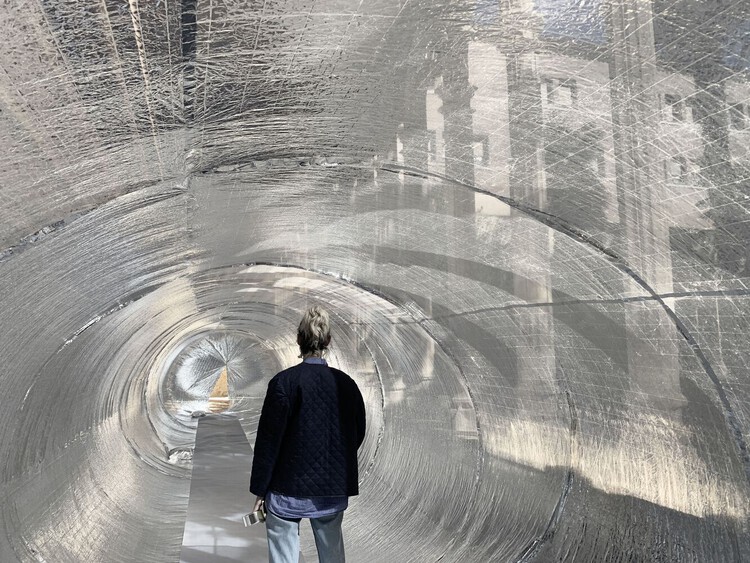
How do inflatable structures behave in public spaces? What relationships or connections can they establish among people? From the perspective of Conjuntos Empáticos, inflatable structures act as organisms that engage passersby through their lightness, materiality, and element of surprise, ensuring sensory experiences in various environments and public spaces. These structures can accommodate everything from collective interventions to moments of leisure, encouraging social interaction and creating atmospheres that dissociate the scale of the city from the domestic space.
Based in Spain, the nonprofit association Conjuntos Empáticos was founded in 2012 by Sálvora Feliz, Jose A. Corno, Guillermo González Requeijo, Rodrigo González, Eva Alcalde, and Fabiola Marroyo. Among its goals, the organization aims to disseminate work and knowledge in the fields of architecture, art, pedagogy, and new technologies, promoting best practices while fostering the development of these areas, encouraging citizen participation, and supporting research processes. Their agenda also includes the development of installations, actions, renovation processes, educational initiatives, and the revitalization of spaces in conflict.
"For us, the city can be understood as a fabric sewn together by a series of articulating spaces that should function as urban social activators, materialized at different scales." – Conjuntos Empáticos

By generating human development processes through reflection, participation, and collective knowledge construction from the subjects and actors of society, Conjuntos Empáticos is mainly composed of young architects and architecture students seeking to promote various initiatives in the fields of architecture and culture. Through traveling exhibitions, courses, workshops, conference participation, participatory dynamics, discussion groups, installations, and citizen cooperation projects, they carry out activities that have been implemented in schools, festivals, and collective gatherings such as Eme3, La Playa-220, Arquitecturas Colectivas, and MediaLab Prado.

Over the years, Tomás Pineda, Borja Iglesias, Marta G Soler, Elena M Millana, Andrea Briz, Elena Brunete, Alba González Jimenez, Laura Domínguez Valdivieso, Marta Benito, Noemí Díaz, and Laura G Caballero have collaborated in the direction of Conjuntos Empáticos. Currently, the office is directed by Sálvora Feliz, Marta Benito, and Laura G Caballero, who, with the help of Tomás Pineda and Guillermo González Requeijo along with a large team of collaborators, develop projects of various scales. Their work was showcased at the Spain Pavilion at the Venice Architecture Biennale 2016 and 2018. It was also selected in the International Design Awards 2019 and the Emporia Awards 2018, nominated for the Simon Architecture Prize in 2019 and 2021, and cataloged in the Arquia Próxima Biennial 2018-19, among others.
Beyond carrying out comprehensive renovation projects for homes, businesses, pavilions, or the rehabilitation of public spaces, Conjuntos Empáticos aims to demonstrate how pneumatic architecture can create flexible, lightweight, and temporary environments that encourage interaction among different users and in various spaces. Below, explore a selection of their ephemeral installations along with their descriptions.
TRANS(h)itos Installation / Conjuntos Empáticos

At the Sant Domenec cloister in Balaguer, from October 1 to 15, 2022, the TRANS(h)itos installation emerged as an experimental piece of architectural space in relation to the memory of women. The proposal involved an ephemeral architecture capable of recovering unique stories of women through the construction of an airflow enclosed within a reflective membrane. Engaging in dialogue with its surroundings and creating an atmosphere strange enough to listen to, it offered a sensory experience where space, atmosphere, and memory merged between historical heritage and contemporary ephemeral architecture.

Spherifications Installation / Conjuntos Empáticos

Taking shape in Plaza de Carmelita in Altea in 2022 as part of the La Nit de l'Art Festival, the prototypes of urban spherifications were designed to generate and promote socialization dynamics in interaction with the surrounding environment. Through reflective textures, the space was defined to create new fleeting relationships between static and fluctuating realities. The membrane was inflated using industrial fans, and its clover-shaped configuration encouraged movement dynamics for greater enjoyment of urban space.

This is my Square Intervention / Conjuntos Empáticos

Aiming to promote the use of public space for residents and children, these actions took place in Plaza de Callao, Plaza de Matadero, and the Patio Cal Comte de la Cova, highlighting available spaces suitable for public use and enjoyment. Through permanent or intermittent prototyped actions, the aim is to trigger or reactivate programs in urban environments. Through permanent or intermittent prototyped interventions, the goal was to trigger or reactivate programs in urban environments. Set in locations rarely frequented by certain groups, these interventions attracted a young audience that interacted with the objects and strategies implemented, fostering socialization in city spaces with dimensions larger than standard ones.

This article is part of an ArchDaily series titled Get to Know the Works of, where we look at the built portfolio of a studio, explore their creative process, and highlight their approach. As always, at ArchDaily, we greatly appreciate the contributions of our readers. If you think we should highlight a particular architectural firm, send us your suggestions.









